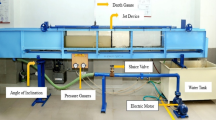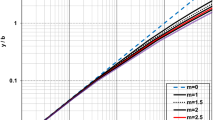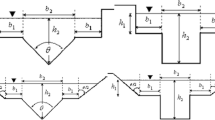Abstract
In this paper, analytical methods, artificial neural network (ANN) and multivariate adaptive regression splines (MARS) techniques were utilised to estimate the discharge capacity of compound open channels (COC). To this end, related datasets were collected from literature. The results showed that the divided channel method with a coefficient of determination (R 2) value of 0.76 and root mean square error (RMSE) value of 0.162 has the best performance, among the various analytical methods tested. The performance of applied soft computing models with R 2=0.97 and RMSE = 0.03 was found to be more accurate than analytical approaches. Comparison of MARS with the ANN model, in terms of developed discrepancy ratio (DDR) index, showed that the accuracy of MARS model was better than that of MLP model. Reviewing the structure of the derived MARS model showed that the longitudinal slope of the channel (S), relative flow depth (H r ) and relative area (A r ) have a high impact on modelling and forecasting the discharge capacity of COCs.














Similar content being viewed by others
References
Ackers P 1993 Flow formulae for straight two-stage channels; J. Hydraul. Res. 31 509–531.
Atabay S and Knight D W 2006 1-D modelling of conveyance, boundary shear and sediment transport in overbank flow; J. Hydraul. Res. 44 739–754.
Azamathulla H M and Zahiri A 2012 Flow discharge prediction in compound channels using linear genetic programming; J. Hydrol. 454–455 203–207.
Azamathulla H M, Haghiabi A H and Parsaie A 2016 Prediction of side weir discharge coefficient by support vector machine technique; Water Sci. Technol.: Water Suppl. 16 1002–1016.
Chatila J G and Townsend R D 1996 Discharge estimation methods for steady compound channel flows; Canadian Water Resour. J./Revue canadienne des ressources hydriques 21 131–137.
Chaudhry M H 2007 Open-Channel Flow; Springer US.
Chow V 2009 Open-Channel Hydraulics; Blackburn Press.
Chow V, Maidment D and Mays L 2013 Applied Hydrology; 2nd edn; McGraw-Hill Companies, Inc.
Dehdar-behbahani S and Parsaie A 2016 Numerical modeling of flow pattern in dam spillway’s guide wall. Case study: Balaroud dam, Iran; Alexandria Eng. J. 55 467–473.
Dehghani M, Saghafian B, Nasiri Saleh F, Farokhnia A and Noori R 2014 Uncertainty analysis of streamflow drought forecast using artificial neural networks and Monte-Carlo simulation; Int. J. Climatol. 34 1169–1180.
Fernandes J N, Leal J B and Cardoso A H 2015 Assessment of stage–discharge predictors for compound open-channels; Flow Meas. Instrum. 45 62–67.
Friedman J H 1991 Multivariate adaptive regression splines; The Annals of Statistics 19 1–67.
Haghiabi A H 2016a Prediction of longitudinal dispersion coefficient using multivariate adaptive regression splines; J. Earth Syst. Sci. 125 985–995.
Haghiabi A H 2016b Prediction of river pipeline scour depth using multivariate adaptive regression splines; J. Pipeline Syst. Eng. Pract. 8(1) 04016015. doi:10.1061/(asce)ps.1949-1204.0000248.
Ikeda S and McEwan I K 2009 Flow and sediment transport in compound channels: The experience of Japanese and UK research; Taylor & Francis.
Khatua K, Patra K and Mohanty P 2012 Stage-discharge prediction for straight and smooth compound channels with wide floodplains; J. Hydraul. Eng. 138 93–99.
Knight D W, Demetriou J D and Hamed M E 1984 Stage-discharge relationships for compound channels; In: Channels and channel control structure (ed.) Smith K V H; Springer Berlin Heidelberg, pp. 445–459.
Lenton R and Muller M 2012 Integrated water resources management in practice: Better water management for development; Taylor & Francis.
Mohanty P K and Khatua K K 2014 Estimation of discharge and its distribution in compound channels; J. Hydrodyn. B 26 144–154.
Myers W R C 1987 Velocity and discharge in compound channels; J. Hydraul. Eng. 113 753–766.
Najafzadeh M 2016 Neurofuzzy-based GMDH-PSO to predict maximum scour depth at equilibrium at culvert outlets; J. Pipeline Syst. Eng. Pract. 7 06015001.
Najafzadeh M and Lim S Y 2015 Application of improved neuro-fuzzy GMDH to predict scour depth at sluice gates; Earth Sci. Inform. 8 187–196.
Najafzadeh M and Tafarojnoruz A 2016 Evaluation of neuro-fuzzy GMDH-based particle swarm optimization to predict longitudinal dispersion coefficient in rivers; Environ. Earth Sci. 75 1–12.
Najafzadeh M and Zahiri A 2015 Neuro-fuzzy GMDH-based evolutionary algorithms to predict flow discharge in straight compound channels; J. Hydrol. Eng. 20 04015035.
Najafzadeh M, Barani G -A and Azamathulla H M 2013 GMDH to predict scour depth around a pier in cohesive soils; Appl. Ocean Res. 40 35–41.
Najafzadeh M, Etemad-Shahidi A and Lim S Y 2016 Scour prediction in long contractions using ANFIS and SVM; Ocean Eng. 111 128–135.
Naot D, Nezu I and Nakagawa H 1993 Calculation of compound-open-channel flow; J. Hydraul. Eng. 119 1418–1426.
Noori R and Hooshyaripor F 2014 Effective prediction of scour downstream of ski-jump buckets using artificial neural networks; Water Resour. 41 8–18.
Noori R, Khakpour A, Omidvar B and Farokhnia A 2010 Comparison of ANN and principal component analysis-multivariate linear regression models for predicting the river flow based on developed discrepancy ratio statistic; Expert Syst. Appl. 37 5856–5862.
Noori R, Karbassi A, Ashrafi K, Ardestani M, Mehrdadi N and Nabi Bidhendi G -R 2012 Active and online prediction of BOD5 in river systems using reduced-order support vector machine; Environ. Earth Sci. 67 141–149.
Noori R, Yeh H-D, Abbasi M, Kachoosangi F T and Moazami S 2015 Uncertainty analysis of support vector machine for online prediction of five-day biochemical oxygen demand; J. Hydrol. 527 833–843.
Noori R, Deng Z, Kiaghadi A and Kachoosangi F T 2016 How reliable are ANN, ANFIS, and SVM techniques for predicting longitudinal dispersion coefficient in natural rivers? J. Hydraul. Eng. 142 04015039.
Parsaie A 2016 Analyzing the distribution of momentum and energy coefficients in compound open channel; Model. Earth Syst. Environ. 2 1–5.
Parsaie A and Haghiabi A H 2015 Computational modeling of pollution transmission in rivers; Appl. Water Sci., pp. 1–10.
Parsaie A, Haghiabi A H, Saneie M and Torabi H 2016a Prediction of energy dissipation on the stepped spillway using the multivariate adaptive regression splines; ISH J. Hydraul. Eng. 22 281–292.
Parsaie A, Najafian S, Omid M H and Yonesi H 2016b Stage discharge prediction in heterogeneous compound open channel roughness; ISH J. Hydraul. Eng., pp. 1–8.
Reddy H P, Chaudhry M H and Imran J 2014 Computation of gradually varied flow in compound open channel networks; Sadhana 39 1523–1545.
Sahu M 2012 Prediction of flow and its resistance in compound open channels: Turbulent flow and its assessment for compound open channel flow; Lambert Academic Publishing.
Sahu M, Khatua K K and Mahapatra S S 2011 A neural network approach for prediction of discharge in straight compound open channel flow; Flow Mea. Instrum. 22 438–446.
Samadi M, Jabbari E, Azamathulla H and Mojallal M 2015 Estimation of scour depth below free overfall spillways using multivariate adaptive regression splines and artificial neural networks; Eng. Appl. Comput. Fluid Mech. 9(1) 291–300.
Seckin G 2004 A comparison of one-dimensional methods for estimating discharge capacity of straight compound channels; Canadian J. Civil Eng. 31 619–631.
Seckin G, Mamak M, Atabay S and Omran M 2009 Discharge estimation in compound channels with fixed and mobile bed; Sadhana 34 923–945.
Sharda V, Prasher S, Patel R, Ojasvi P and Prakash C 2008 Performance of multivariate adaptive regression splines (MARS) in predicting runoff in mid-Himalayan micro-watersheds with limited data; Hydrol. Sci. J. 53 1165–1175.
Subramanya K 2009 Flow in open channels; Tata McGraw-Hill.
Tang X, Knight D W and Samuels P G 1999 Variable parameter Muskingum–Cunge method for flood routing in a compound channel; J. Hydraul. Res. 37 591–614.
Unal B, Mamak M, Seckin G and Cobaner M 2010 Comparison of an ANN approach with 1-D and 2-D methods for estimating discharge capacity of straight compound channels; Adv. Engin. Softw. 41 120–129.
Wormleaton P and Hadjipanos P 1985 Flow distribution in compound channels; J. Hydraul. Eng. 111 357–361.
Wormleaton P R and Merrett D J 1990 An improved method of calculation for steady uniform flow in prismatic main channel/flood plain sections; J. Hydraul. Res. 28 157–174.
Zahiri A and Azamathulla H M 2014 Comparison between linear genetic programming and M5 tree models to predict flow discharge in compound channels; Neural Comput. Appl. 24 413–420.
Zhang W and Goh A T C 2014 Multivariate adaptive regression splines and neural network models for prediction of pile drivability; Geosci. Front. 7 (1) 45–52.
Acknowledgement
We are grateful to Dr Hojjatallah Yonesi, Assistant Professor at Lorestan University, Khorramabad, Iran, who introduced us to the advanced concept of compound open channel hydraulics.
Author information
Authors and Affiliations
Corresponding author
Additional information
Corresponding editor: Subimal Ghosh
Rights and permissions
About this article
Cite this article
PARSAIE, A., HAGHIABI, A.H. Mathematical expression of discharge capacity of compound open channels using MARS technique. J Earth Syst Sci 126, 20 (2017). https://doi.org/10.1007/s12040-017-0807-1
Received:
Revised:
Accepted:
Published:
DOI: https://doi.org/10.1007/s12040-017-0807-1




